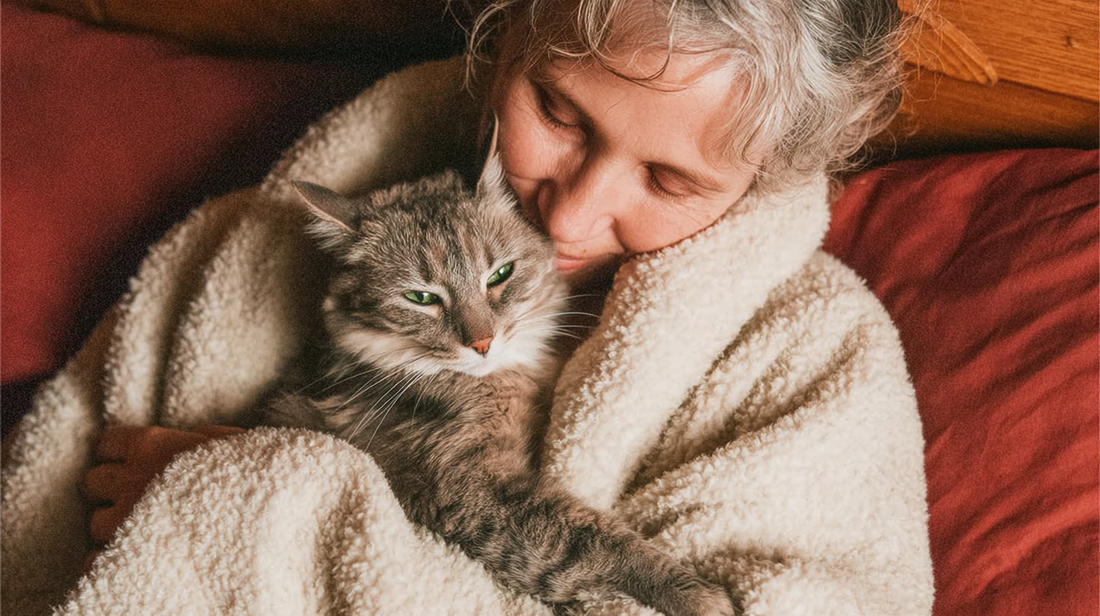Witnessing your beloved cat experience a seizure related to feline epilepsy can feel terrifying and emotionally overwhelming. These episodes, though often brief, leave you feeling helpless and uncertain about what steps to take next. As veterinarians, our goal with this guide is to empower you with essential knowledge, helping you understand what seizures are, why they occur, and how you can best support your feline companion. Feline epilepsy ranks among the most common neurological problems we see in veterinary medicine, and understanding how to respond effectively is crucial for successful management.
Summary
What happens inside your cat's brain during a seizure
Understanding the neurological "electrical storm"
At its core, a seizure represents a temporary disruption in your cat's normal brain function. Think of it as a brief "electrical storm" within the brain, triggered by hyperexcitable, hypersynchronous neuronal activity. This sudden burst of uncontrolled electrical signals creates the various physical and behavioral changes you observe.
Recognizing seizure symptoms in your cat
Seizures in cats present themselves in various ways, ranging from subtle changes to dramatic convulsions. You'll want to watch for impairment of consciousness, where your cat appears dazed, unresponsive, or completely unaware of their surroundings. Behavioral changes encompass anything unusual for your specific cat, such as sudden aggression or extreme vocalization. Involuntary motor activity includes movements like twitching, rhythmic paddling of the limbs, or sudden stiffening throughout the body. Autonomic nervous system alterations may present as dilated pupils, excessive drooling, vomiting, urination, or defecation.
What's important to remember is that not all seizures appear dramatic. Your cat may also experience "focal seizures," which affect only a smaller portion of the brain and often produce more subtle clinical features that prove much harder to identify.

The three stages of a seizure episode
Every seizure event typically unfolds in three distinct phases. The prodromal phase represents the period leading up to the seizure, which can last anywhere from hours to several days. During this time, you might observe subtle changes in your cat's behavior, such as restlessness, increased anxiety, unusually strong demands for attention, or a tendency to hide.
The ictal phase constitutes the actual seizure itself, during which you'll observe all those clinical signs we discussed above. While this phase often appears brief, it can feel significantly longer when you're witnessing your cat go through it. The postictal phase follows immediately after the seizure ends, when your cat may appear fatigued, disoriented, or restless, and might engage in compulsive walking. Some cats demonstrate temporary aggression, uncoordinated movements (ataxia), increased hunger, or even temporary blindness. These post-seizure signs can persist anywhere from minutes to several days.
Why feline epilepsy happen: Uncovering the underlying causes
The importance of proper diagnosis
When your cat experiences a seizure, identifying the underlying cause becomes absolutely critical for effective long-term management. Because seizures can stem from such a wide array of conditions, reaching an accurate diagnosis requires a careful and methodical approach from your veterinary team.
Medical conditions that trigger cat seizures
Neurological issues encompass seizures that originate directly from brain abnormalities, such as psychomotor or partial seizures, or conditions like peripheral neuropathy. Nutritional deficiencies can trigger seizures when specific dietary imbalances develop. Deficiencies in vital nutrients like thiamine (Vitamin B1), taurine, or tryptophan can all lead to seizure activity.
Thiamine deficiency proves particularly common in cats that are anorexic or those fed diets high in thiaminase (found in raw fish), and we've linked it to certain canned cat foods. Diets containing excessive cereal content or meat cooked at very high temperatures can also contribute to this deficiency.
Infections represent another significant category, as various infectious diseases can impact the brain and trigger seizures, including rabies, pseudorabies, toxoplasmosis, Neospora caninum, Feline Immunodeficiency Virus (FIV), and Feline Infectious Peritonitis (FIP). Inflammation or pain from chronic conditions can sometimes contribute to seizure activity. Examples include feline interstitial cystitis, granulomatous meningioencephalitis, or arthritis.
Toxins present another serious concern, as exposure to harmful substances like heavy metals (lead or zinc) or certain medications can induce seizures. Trauma from any brain injury or traumatic events, even those from your cat's past, can serve as underlying causes of seizures. Vascular issues, particularly problems with blood flow to the brain, such as a cerebral infarct (stroke), can trigger seizure episodes.

How your observations help with accurate diagnosis
Since seizures occur unpredictably and episodically, we often don't witness them directly in our veterinary clinic. This makes your detailed observations incredibly valuable to us. To assist your veterinarian most effectively, we recommend keeping detailed descriptions by paying close attention to your cat's behavior immediately before, during, and after each episode. Make sure to note whether your cat appears completely normal between events.
Identifying triggers proves equally important—try to determine if seizures occur while your cat is resting or active, or if specific events like eating or excitement seem to trigger them. Video recording, when safe to do so, can provide immense help for veterinarians, as these recordings prove extremely useful in distinguishing between epileptic and non-epileptic events.
Charting your observations by maintaining a consistent record of all observed or suspected seizures is also crucial. A simple calendar noting the date, time, and brief description of each event can prove very effective.
Managing seizures: Immediate response and long-term care
Emergency response during a seizure
While witnessing a seizure feels frightening, your primary role focuses on ensuring your cat's safety and observing accurately for your veterinarian. Most importantly, you must remain calm. Your cat isn't aware of what's happening, and your panic won't help them. Ensure your cat remains in a safe space where they cannot fall or injure themselves. Move any obstacles away when possible.
You should never attempt to restrain your cat or place anything in their mouth, as this can lead to serious injury for both of you. Time the seizure from beginning to end, and make mental notes of all specific behaviors you observe. Be sure to record this information for your next veterinary visit.
Creating a successful long-term management plan
Managing epilepsy or recurrent seizures in cats often requires a lifetime commitment from you. Your close collaboration with your veterinarian becomes essential for proper disease management and achieving optimal quality of life for your cat. Commitment to care means preparing yourself for the ongoing responsibility of administering medications, attending periodic re-evaluations, and potentially undergoing further diagnostic tests. You'll need to monitor your cat closely for any adverse effects of therapy.
Maintaining realistic expectations proves important throughout this journey. While we always strive for the best outcomes, complete seizure elimination may not always be achievable. Our primary focus centers on achieving a good balance between effective treatment and your cat's overall quality of life.
Open communication forms the foundation of proper client education, which proves critical for success. We aim to provide clear, empathetic discussions, avoiding medical jargon whenever possible. You should never hesitate to ask questions for clarification.

Your action plan for living with a seizure-prone cat
Five essential steps for cat owners
Document everything by maintaining a precise log of every seizure event, including date, time, duration, behaviors observed, and potential triggers. Video recordings prove immensely helpful when safe and practical to obtain.
Communicate regularly by maintaining open communication with your veterinary team. You should never hesitate to ask questions about your cat's condition, treatment plans, or expectations.
Adhere to recommendations, as consistency proves vital for effective seizure management. You must strictly follow all medication schedules and attend all recommended follow-up appointments.
Prioritize quality of life by working closely with your veterinarian to ensure your cat's management plan not only controls seizures but also supports their overall well-being.
Seek professional help by always consulting with your veterinarian for diagnosis and a tailored management plan. Self-treatment or relying on unreliable sources can prove detrimental to your cat's health.

The information in this article is based on the following scientific publications:
Elliott, J., & Grauer, G. (Eds.). (2006-2007). BSAVA Manual of Canine and Feline Nephrology and Urology (2nd ed.). BSAVA Publications.
Villiers, E., & Blackwood, L. (Eds.). (2005). BSAVA Manual of Canine and Feline Clinical Pathology (2nd ed.). BSAVA Publications, Gloucester
Horwitz, D. F., & Mills, D. S. (Eds.). (2009). BSAVA Manual of Canine and Feline Behavioural Medicine (2nd ed.). BSAVA Publications, Gloucester.
Harvey, A., & Tasker, S. (Eds.). BSAVA Manual of Feline Practice: A Foundation Manual. BSAVA Publications.
Rendle, M., & Hinde-Megarity, J. (Eds.). (2022). BSAVA Manual of Practical Veterinary Welfare (1st ed.). BSAVA Publications.




